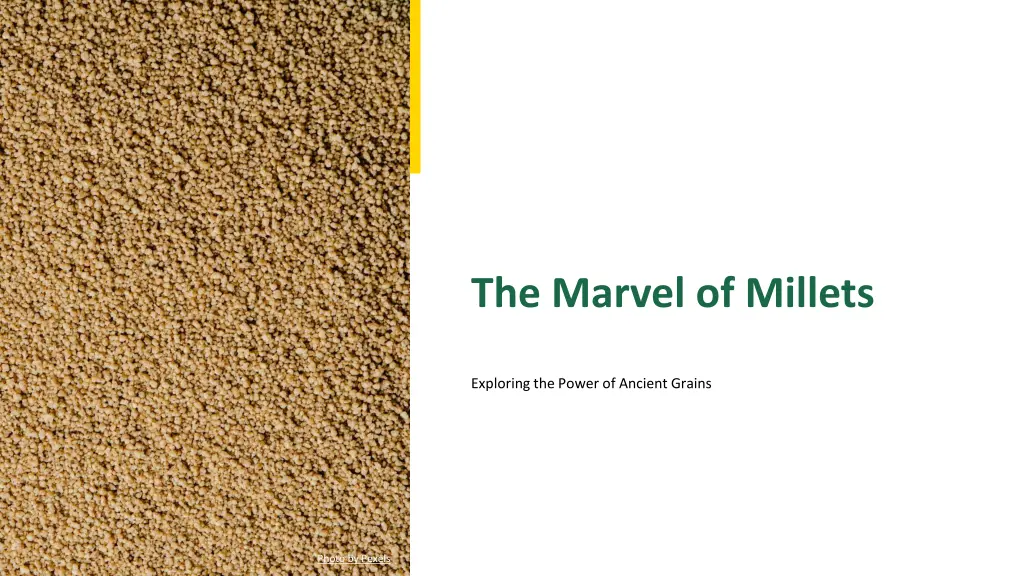
Exploring the Marvel of Millets: Ancient Grains Unveiled
Discover the power of millets, ancient grains rich in nutrients and sustainability. Learn about the types, health benefits, environmental impact, culinary uses, economic importance, and challenges in millet cultivation. Unveil the future of millets and their global significance.
Download Presentation

Please find below an Image/Link to download the presentation.
The content on the website is provided AS IS for your information and personal use only. It may not be sold, licensed, or shared on other websites without obtaining consent from the author. If you encounter any issues during the download, it is possible that the publisher has removed the file from their server.
You are allowed to download the files provided on this website for personal or commercial use, subject to the condition that they are used lawfully. All files are the property of their respective owners.
The content on the website is provided AS IS for your information and personal use only. It may not be sold, licensed, or shared on other websites without obtaining consent from the author.
E N D
Presentation Transcript
The Marvel of Millets Exploring the Power of Ancient Grains Photo by Pexels
01 Introduction to Millets Table of Contents 02 Types of Millets 03 Health Benefits 04 Environmental Impact 05 Culinary Uses 06 Economic Importance 07 Challenges in Millet Cultivation 08 Innovations in Millet Farming 09 Millets in Global Diets 10 Future of Millets 11 Conclusion 12 Q&A Session
1 Introduction to Millets The Ancient Superfood Millets are a group of highly variable small-seeded grasses, widely grown around the world as cereal crops or grains for fodder and human food. Millets have been cultivated for thousands of years and were a staple in ancient civilizations. Rich in proteins, fiber, vitamins, and minerals, millets are a powerhouse of nutrition. Millets are primarily grown in Asia and Africa, with India being the largest producer. Photo by Pexels
2 Types of Millets Diverse Varieties Known for its high iron content, pearl millet is a staple in arid regions. Rich in calcium, finger millet is often used in porridge and baked goods. A good source of complex carbohydrates, foxtail millet is easy to digest. Also known as jowar, sorghum is versatile and used in various culinary dishes. Photo by Pexels
3 Health Benefits Why Choose Millets? Millets help in reducing cholesterol levels and improving heart health. Low glycemic index makes millets ideal for managing blood sugar levels. High fiber content aids in weight loss and maintaining a healthy weight. Millets promote a healthy digestive system due to their high fiber content. Photo by Pexels
4 Environmental Impact Sustainable Farming Millets require less water and are highly drought-resistant, making them ideal for arid regions. They require minimal fertilizers and pesticides, reducing farming costs. Millets improve soil health by preventing erosion and enhancing fertility. Cultivating millets supports agricultural biodiversity. Photo by Pexels
5 Culinary Uses Versatile and Delicious Millets are used in a variety of traditional dishes across cultures. Incorporating millets into modern recipes for a healthy twist. Millets serve as an excellent gluten-free alternative for those with celiac disease. Millets are also used in brewing traditional and modern beverages. Photo by Pexels
6 Economic Importance Boosting Local Economies Millet farming creates jobs in rural areas, boosting local economies. Growing demand for millets in health-conscious markets. Millets have significant export potential due to their health benefits. Many governments are promoting millet cultivation through subsidies and supportprograms. Photo by Pexels
7 Challenges in Millet Cultivation Overcoming Barriers Many farmers are unaware of the benefits and techniques of millet cultivation. Limited access to markets for small-scale millet farmers. Need for more research to improve millet yields and resistance. Inadequate policy support in some regions hinders millet cultivation. Photo by Pexels
8 Innovations in Millet Farming Embracing Technology Development of high-yield and disease-resistant millet varieties. Using technology to optimize millet farming practices. Processing millets into value-added products for better marketability. Local communities coming together to promote millet farming. Photo by Pexels
9 Millets in Global Diets A Rising Trend Increasing popularity of millets in health-conscious diets worldwide. Millets being incorporated into international cuisines. Influence of celebrities promoting millets as a superfood. Millets as a medium for cultural exchange throughfood. Photo by Pexels
10 Future of Millets Towards a Sustainable Future Millets as a solution to climate change challenges in agriculture. Potential of millets to contribute to global food security. Ongoing research to unlock the full potential of millets. International efforts to promote millet cultivation and consumption. Photo by Pexels
11 Conclusion Embracing Millets Recap of the numerous benefits of incorporating millets into our diets. Encouraging individuals and communities to embrace millets for a healthier future. Reflecting on the journey of rediscovering millets. Envisioning a future where millets play a key role in sustainable living. Photo by Pexels
12 Q&A Session Engage and Explore Inviting questions and discussions from the audience. Providing expert insights and clarifications on millets. Audience members share their experiences with millets. Collecting feedback and suggestions for futurepresentations. Photo by Pexels
